Evolving the ability to walk on tiptoes helped mammals become the chunkiest animals on the planet, according to new research by evolutionary biologist Dr Manabu Sakamoto. But could it also give us clues on how dinosaurs got so big? He explains more.
Most of the biggest animals in existence are mammals, and they occupy almost all environments imaginable – from deserts to tundra. They also span six orders of magnitude in body size range, from the tiny Etruscan shrew (1.8 grams) to the giant African elephant (4-6 metric tonnes).


The key to their success and diversity in body size is that mammals have evolved various adaptations in their limbs related to walking, in particular foot postures. Flat-footed (plantigrade) mammals walk and stand on their entire foot, from toe to heel. Tip-toed mammals stand on their digits, often on foot pads. Hooved mammals essentially walk and stand like ballerinas. Non-plantigrade postures have only been acquired in mammals and dinosaurs – birds walk on their three toes.
As both mammals and dinosaurs have been the biggest terrestrial animals over millions of years, could their unique foot postures may have given them an evolutionary advantage over others?
Waiting in the shadows
Both early dinosaurs and early mammals started out small and lived in the shadows of larger animals for millions of years before they rose to dominance. Dinosaurs appeared around 240 million years ago into a world dominated by giant terrestrial reptiles. They only diversified and took over as the biggest land-dwelling creatures once the dominant reptiles had been wiped out by two phases of mass extinction events around 225 and 200 million years ago.


Coelophysis, one of the first dinosaurs, appeared in the Late Triassic when carnivorous reptiles such as Proterosuchus dominated. Mass extinction events wiped out these reptiles and subsequently allowed dinosaurs to take over (Images: Dr. Jeff Martz/NPS, Nobu Tamura –Wikimedia commons )
Similarly, mammals also lived in the shadows of dinosaurs for about a hundred million years before they successfully diversified into the wide range of animals we see today. Common to both dinosaurs and mammals is that they quickly seized the available ecological opportunities and rapidly diversified in species diversity and body size.
Gaining an evolutionary foothold
In a recent study I published in PNAS with my long-time friend and colleague, Dr Tai Kubo from the University of Tokyo along with Dr Andrew Meade and Dr Chris Venditti from the School of Biological Sciences, we investigated how foot posture affected the evolution of body size in 880 living mammal species.
Tai had painstakingly collected foot postures in over 2,000 species of mammals from videos of them walking – an incredible effort in itself. We matched 880 of those 2,000 species to the mammalian tree of life – which traces the branching evolutionary history of all known mammalian life. Using a Bayesian statistical method, this helped us to reconstruct the evolutionary history of foot postures and body size.
Our work showed that the posture of the first mammal was flat-footed, consistent with what we know of the earliest mammals from the fossil record. We also determined that evolutionary changes between flat-footed and tip-toed, and between tip-toed and hooved mammals occurred relatively freely in either direction, but there were no transitions between flat-footed and hooved postures – this is also expected given the fossil record.
Behemoth ballerinas
Next we turned our attention to how evolution of foot postures could have affected the evolution of body size. We wanted to test the theory that transitions in foot postures would be linked with faster body size evolution. After all, flat-footed mammals, on average weigh around 0.75 kg, tip-toed ones around 1 kilo and hooved mammals (with ‘ballerina feet’) around 78kg. Could these differences have come about through episodes of rapid evolution?
When we looked at body size evolution across lineages in which changes in posture occurred compared with those across which posture remained the same we found that the former tended to evolve into bigger animals. Our results show that body size evolves rapidly when foot postures change but reverts back to a slower gradual evolution once the new posture is attained.

It might be that changes in foot posture facilitate increases in body size owing to more efficient weight support and energetics, allowing for rapid expansion of mammals into large-bodied ecological niches that gave them new advantages. Or it could be that rapid increases in body size necessitate changes in foot postures. This ‘chicken or egg’ question is still up for debate.
What about dinosaurs?
Through our research we have revealed that changes in foot postures played a key role in the evolution of body size in mammals – namely in how rapidly they got bigger, which may have helped them quickly become the dominant terrestrial animals.
Tai and I are now planning a scientific investigation into whether or not dinosaurs evolved through similar mechanisms – i.e. whether changes in limb shape and size led to rapid evolution, or perhaps whether drastic changes in environments led to rapid evolution.
In any case, we hope our future research can shed light onto how these ancient giants came to dominate the globe for over a hundred million years. Watch this space for updates.
Dr Manabu Sakamoto is an evolutionary biologist within Reading’s School of Biological Sciences. His research focuses on how biodiversity waxes and wanes through the history of the Earth, with special interest in various vertebrates groups such as dinosaurs. Read our news story on this research.

